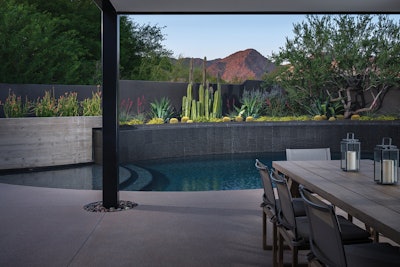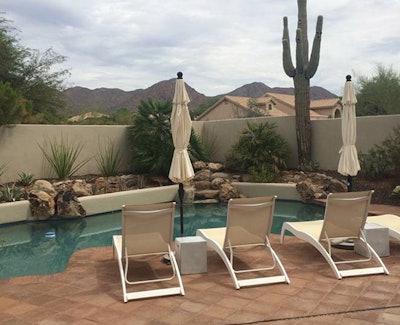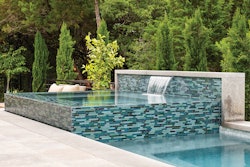
 In the before photo above, the light-colored roofline of a neighboring house draws the eye away from the majestic desert mountain view.
In the before photo above, the light-colored roofline of a neighboring house draws the eye away from the majestic desert mountain view.
We often hear from clients, "I'm not sure what I like, but I'll know when I see it." Or, "I know what I like, but I'm not sure how to put it together." In both instances, they are not yet asking us to be pool builders. First, they need us to be composers, or sculptors. This cerebral planning stage is quite a different thought process altogether from the practical "let's get it built" workflow that occupies most of our day.
To uninitiated clients, exceptional results that transcend to the level of art — the kind that stir an emotional response — seem like magic. But for us to create this "magic" consistently, we must understand the details and the precepts behind the orchestration that bring about a harmonious result, rather than an outcome that feels chaotic or disjointed.
That elusive "gestalt," as it is formally called, where the synergy of elements is so strong that it becomes something else, and stops the observer in their tracks, that effect can only come by harnessing the timeless principles of composition that we see utilized in art and media. When we weave our scenes together at a musical level, or in a sculptural way, that is when we will elicit that epiphany-like reaction from our patrons more predictably.
Michael Woodall, my photographer and friend of 25 years, paid me a compliment once that led me to understand this conversation at a deeper level. He said, "So many times, I show up to do a photoshoot (for others), and I struggle to get the shot, because it's not clear to me what I am supposed to be looking at. But when I photograph your projects, it's obvious where I'm supposed to stand, and where I'm supposed to point the camera." This led me to really think more about what I was doing as second nature, in a way that I could articulate it to others.
Where do we begin? If I could communicate only one idea that could dramatically shift one's work, it would be this.
Strategy No. 1: Clearly define your subject, then every other decision reinforces this choice.
I'm glad that I took an art history class in college; that was very impactful. In every slide that went up, the first question the instructor asked of us was, "What (or whom) is THE subject of this piece?" Sometimes there were so many contributing elements that it would take a moment of reflection to discern who played the lead in the particular scene. In a well-composed piece, the subject was clear, and the other elements played a supportive role, and did not steal attention away.

Insight No. 1: The pool is not the subject! Drumroll please...the water feature(s) are usually not the subject either.
What? How is this possible? Why is the pool itself not the primary subject? Or at least the water features?
First, the surface area that we think of as "the pool" is a ground plane element. We inhabit the world standing up, looking out at eye level, not flying overhead, looking down. That means, whatever is vertical and upright, as we are, that is what we recognize as an element in the scene to be contended with. The pool? It's just part of the floor!
Said differently, an element that can hold enough space to claim the identity of "the subject" in a scene is going to be upright and have enough scale so as to be recognized as the dominant player in the scene. Water features may lead the eye to something you want to show off beyond, but unless they occupy a significant percentage of the view under consideration, they just aren't large enough typically to be the star of the show. They play a supportive role.
I would argue that most pictures of pools you see lack a subject in the scene.
 Subtle uplighting of the cacti and other plantings add lush mystique to the aquatic landscape painting, which now forms the backdrop of this home.
Subtle uplighting of the cacti and other plantings add lush mystique to the aquatic landscape painting, which now forms the backdrop of this home.
They are an empty stage.
Look at any well-composed painting or photograph. You will note three layers of space: foreground, middle ground, and background. You will also note that the subject of the piece is at the horizon line from the person's point of view. If it's an element that takes up space, it's usually found in the middle ground. Conversely, if it's a non-physical element like a view, it will be in the background layer. Rarely is the subject placed in the foreground, and it's certainly not a ground plane element, like the pool.
What are some elements that are worthy of being called the subject? A great view beyond, provided the breadth of the vista takes up enough of the background to have a role in the space.
- A unique tree or landscape planting arrangement, or large sculpture (that takes up enough space in the view to be dominant within the scene).
- Water features that are tall enough to be at eye level or greater, that also have enough breadth to be dominant in the scene.
- Water features that are tall enough to be at eye level or greater, that also have enough breadth to be dominant in the scene.
- Architectural elements, like an outdoor fireplace with a prominent chimney, or an accessory structure with a proud facade, or a pergola or similar structure that defines a place.
Note: All of these elements must have enough scale to occupy a significant portion of the canvas, the scene one beholds when gazing at the backyard from a particular vantage point.

As a case study, let's examine the Meeker-Namie Residence here in Scottsdale, Ariz.
In the before picture on the opening page, you'll note that they have a great mountain view toward the middle back of the property. However, the neighbor's roofline beyond and to the right is so dominant that it draws the eye irresistibly and competes with the mountain view.
The design solution for this space was:
- Preserve the view, and frame it.
- Obscure the roofline of the house that was competing for attention by screening it with a bonzai-like ironwood tree, which now becomes the new focal element within the space.
- Balance the ironwood tree with a vertical cacti element on the opposite side.
- Determine the waterfeature location (leaving space for the plantings), to be used as the silver platter upon which all of this is served. The water feature is a supportive role, not the main star. It has breadth, but not enough height to be the subject. Instead, it underlines all of the good stuff we want you to look at.
- The pool? It's a ground plane mirror in the foreground, merely reflecting the main elements composed beyond, in the middle ground, where all of the action is.
That's enough to take in for one day. Think about other pool photos you've seen in light of defining the proper subject of the scene.
Going forward, as you look at your own projects and others, look to the middle ground and background layers and ask, "Who will be the star in this scene?" Just that simple question will help you create more compelling settings for your clients to enjoy.
 By masterfully combining the three disciplines of landscape design, pool design, and exterior architecture, GENESIS instructor Kirk Bianchi elevates outdoor living to an art form. His talent, experience and wholistic approach allows him to personalize design and create a one-of-kind sanctuary for his clients. His work has won numerous awards including Luxury Pools Pinnacle award, Phoenix Home & Garden "Master of the Southwest," and multiple Best of Houzz awards.
By masterfully combining the three disciplines of landscape design, pool design, and exterior architecture, GENESIS instructor Kirk Bianchi elevates outdoor living to an art form. His talent, experience and wholistic approach allows him to personalize design and create a one-of-kind sanctuary for his clients. His work has won numerous awards including Luxury Pools Pinnacle award, Phoenix Home & Garden "Master of the Southwest," and multiple Best of Houzz awards.
This article first appeared in the April 2023 issue of AQUA Magazine — the top resource for retailers, builders and service pros in the pool and spa industry. Subscriptions to the print magazine are free to all industry professionals. Click here to subscribe.












































